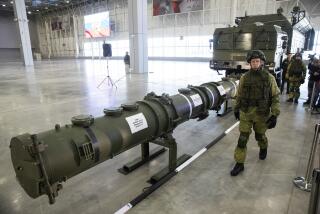Pravda Prints SS-20 Photo in ‘Farewell’
- Share via
MOSCOW — The Soviet public was shown for the first time Thursday a photo of the SS-20 intermediate-range missile in a kind of “hail and farewell” article in the newspaper Pravda.
The story by Alexander Prokhanov, the Communist Party paper’s defense expert, called the missile “a lethal machine” that has served the country well.
However, Prokhanov emphasized that “we are now beginning to transfer the expertise, resources and technology into more productive areas.” This shifting of resources was one of the key benefits from the treaty signed last week in Washington by President Reagan and Soviet leader Mikhail S. Gorbachev, eliminating ground-launched medium-range missiles worldwide, he said.
Reporting from a missile unit, the writer revealed that the SS-20 designation was in fact a North Atlantic Treaty Organization title, not a Soviet one. The Soviets, he said, called the weapon the RSD-10, the letters standing for “medium-range rocket.”
“Today,” said Prokhanov, “the missile unit is preparing to dismantle its battalions, thus removing the nuclear tent over whole zones of Europe.” However, Prokhanov stressed that the Soviet army took part in the “new thinking” that led to the offer to dismantle all intermediate-range nuclear missiles and that the military high command fully supported Gorbachev’s and the Politburo’s decision to junk the missiles.
“Only a silly or biased person can allow himself to accuse our military of militaristic thinking,” he wrote.
“It would be naive to think that the painful and massive task that disarmament presents could be carried out without the participation of the military, against their will, and without their ideas and knowledge,” he added.
The “dismantling of missiles” does not stand for the “dismantling of defensive mentality,” he noted.
As if to reassure readers, he pointed out that “the RSD-10 will be on the combat stations for at least three years after the ink dries up on the treaty copies.”
In the photo accompanying the article, the long, tubular SS-20 was pictured on its mobile, 12-wheel combination carrier-launcher.
It was the introduction of the SS-20s into Eastern Europe that led the NATO powers to respond with medium-range Pershing 2 and cruise missiles.
Meanwhile, a poll of 500 Moscow residents by the Academy of Sciences Sociological Research Institute found that only 8% of those questioned said they think the treaty would harm the Soviet Union. Pravda quoted the institute’s director, Vilen N. Ivanov, as saying that 37% believed that the treaty would strengthen the nation’s security, while 43% said that the accord would not reduce the Soviet Union’s defensive capability.
More to Read
Sign up for Essential California
The most important California stories and recommendations in your inbox every morning.
You may occasionally receive promotional content from the Los Angeles Times.








